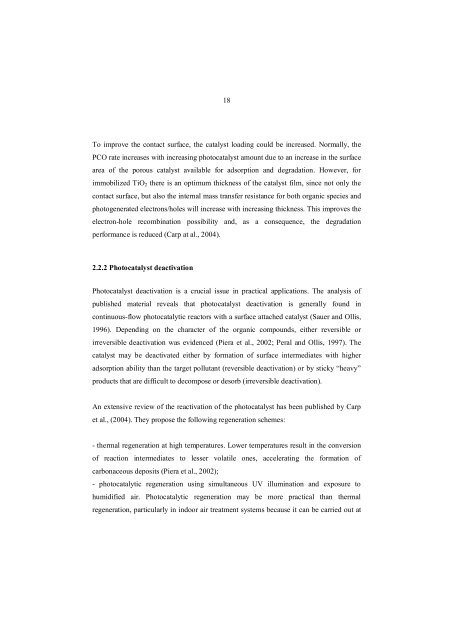gas-phase photocatalytic oxidation of volatile organic ... - Doria
gas-phase photocatalytic oxidation of volatile organic ... - Doria
gas-phase photocatalytic oxidation of volatile organic ... - Doria
Create successful ePaper yourself
Turn your PDF publications into a flip-book with our unique Google optimized e-Paper software.
18<br />
To improve the contact surface, the catalyst loading could be increased. Normally, the<br />
PCO rate increases with increasing photocatalyst amount due to an increase in the surface<br />
area <strong>of</strong> the porous catalyst available for adsorption and degradation. However, for<br />
immobilized TiO2 there is an optimum thickness <strong>of</strong> the catalyst film, since not only the<br />
contact surface, but also the internal mass transfer resistance for both <strong>organic</strong> species and<br />
photogenerated electrons/holes will increase with increasing thickness. This improves the<br />
electron-hole recombination possibility and, as a consequence, the degradation<br />
performance is reduced (Carp at al., 2004).<br />
2.2.2 Photocatalyst deactivation<br />
Photocatalyst deactivation is a crucial issue in practical applications. The analysis <strong>of</strong><br />
published material reveals that photocatalyst deactivation is generally found in<br />
continuous-flow <strong>photocatalytic</strong> reactors with a surface attached catalyst (Sauer and Ollis,<br />
1996). Depending on the character <strong>of</strong> the <strong>organic</strong> compounds, either reversible or<br />
irreversible deactivation was evidenced (Piera et al., 2002; Peral and Ollis, 1997). The<br />
catalyst may be deactivated either by formation <strong>of</strong> surface intermediates with higher<br />
adsorption ability than the target pollutant (reversible deactivation) or by sticky “heavy”<br />
products that are difficult to decompose or desorb (irreversible deactivation).<br />
An extensive review <strong>of</strong> the reactivation <strong>of</strong> the photocatalyst has been published by Carp<br />
et al., (2004). They propose the following regeneration schemes:<br />
- thermal regeneration at high temperatures. Lower temperatures result in the conversion<br />
<strong>of</strong> reaction intermediates to lesser <strong>volatile</strong> ones, accelerating the formation <strong>of</strong><br />
carbonaceous deposits (Piera et al., 2002);<br />
- <strong>photocatalytic</strong> regeneration using simultaneous UV illumination and exposure to<br />
humidified air. Photocatalytic regeneration may be more practical than thermal<br />
regeneration, particularly in indoor air treatment systems because it can be carried out at

















